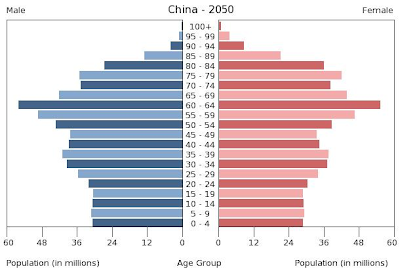The world’s inhabitants in 2012 are an older mix of people than was the case a decade ago, driven by declining fertility and increasing life expectancy. According to new U.S. Census Bureau population projections, by midcentury most world regions will resemble Europe, which in 2005 became the first major world region where the population 65 and older outnumbered those younger than 15 (see Figure 1).
 |
| Figure 1: Europe Population Pyramid: 2005 |
Northern America, which includes Canada and the United States, will have joined Europe in this historic reversal of age group sizes by 2050 (see Figure 2), as will Asia (Figure 3), Latin America (see Figure 4) and Oceania (which includes Australia and New Zealand) (see Figure 5).
 |
| Figure 2: Northern America Population Pyramid 2050 |
 |
| Figure 3: Asia Population Pyramid 2050 |
 |
| Figure 4: Latin America and the Caribbean Population Pyramid 2050 |
 |
| Figure 5: Oceania (Includes Australia and New Zealand) Population Pyramid 2050 |
 |
| Figure 6: China Population Pyramid 2050 |
Each of these projections come from an update of the Census Bureau’s International Data Base, which includes estimates by age and sex to 100 years and older for countries and other areas with populations of 5,000 or more and provides information on population size and growth, mortality, fertility and net migration.
Since April 2012, users of the International Data Base have been able to obtain population in single years of age, allowing them to calculate country-specific populations in particular age groups (e.g., population at selected ages younger than 5, or adolescents).
Between now and the middle of the 21st century, global population will continue aging. The percentage of population 65 and older will more than double, from 8 percent today to nearly 17 percent in 2050, carrying with it well-established changes in the mix of communicable and noncommunicable disease patterns in populations, health care burden, pension systems, the composition and character of the labor force, and other economic variables, such as savings and consumption patterns.
One world region — Africa — will continue to have populations younger than 15 that are much larger than those 65 and older, but even there, the balance will have shifted toward the older group (see Figure 7).
 |
| Figure 7: Africa Population Pyramid 2050 |
View and Download Data
Want to explore additional population projections by country or region? View the data included in the charts above and more from the U.S. Census Bureau’s International Programs – International Data Base page at: http://www.census.gov/population/international/data/idb/informationGateway.php
This news release was provided by the U.S. Census Bureau with graphics added by the Connecticut State Data Center.
